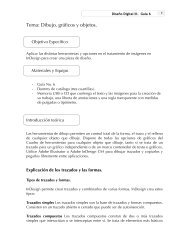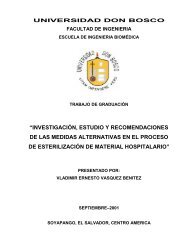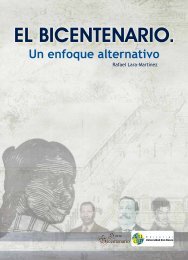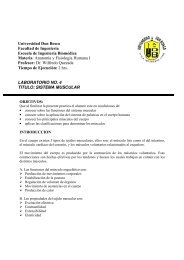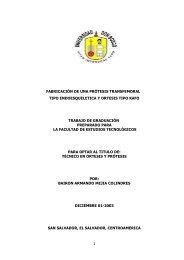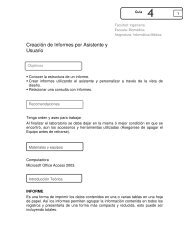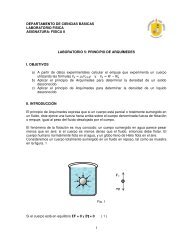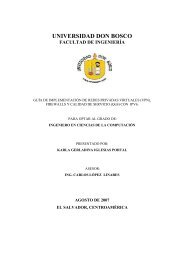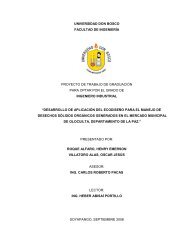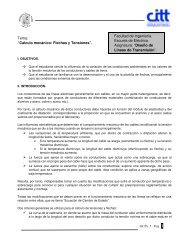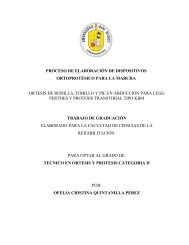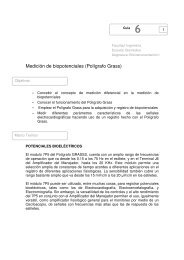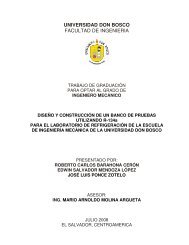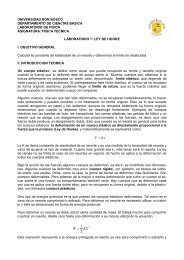cuentos de barro - DSpace Universidad Don Bosco
cuentos de barro - DSpace Universidad Don Bosco
cuentos de barro - DSpace Universidad Don Bosco
You also want an ePaper? Increase the reach of your titles
YUMPU automatically turns print PDFs into web optimized ePapers that Google loves.
la caSa<br />
eMBruJaDa<br />
La casa vieja estaba abandonada allí,<br />
en el centro <strong>de</strong>l enmontado platanar.<br />
La breña bía ido ispiando por las<br />
claraboyas que los temblores abrieran<br />
para ispiar ellos. Tenía una mediagua<br />
embruecadiza, don<strong>de</strong> hacían novenario<br />
perpetuo los panales <strong>de</strong>votos. En los<br />
otros tres lados, ni una puerta; apenas<br />
un rellano <strong>de</strong> empedrado, ya perdido<br />
entre el zacate que lambía gozoso las<br />
pare<strong>de</strong>s lisas: aquella carne <strong>de</strong> casa,<br />
blanquiza en la escurana vegetal, con<br />
un blancor que <strong>de</strong>ja ganas <strong>de</strong> tristeza y<br />
que infun<strong>de</strong> cariño.<br />
Los mosquitos se prendían en el<br />
silencio, como en un turrón. El tejado,<br />
musgoso y renegrido, era como la<br />
arada en un cerrito tristoso. El viento<br />
había sembrado allí una que otra gotera<br />
fructífera, con ráices diagua y flores<br />
redonditas <strong>de</strong> sol, que caminaban por<br />
el suelo y las pare<strong>de</strong>s <strong>de</strong>l interior. La<br />
casa vieja taba dijunta, en<strong>de</strong>rrepente.<br />
Según algunos vecinos, aquel abandono<br />
se <strong>de</strong>bía a que laija <strong>de</strong>l viejito Morán,<br />
que vivió allí, bía muerto tisguacal . 76<br />
38<br />
THe HauNTeD<br />
HouSe<br />
The old house had been abandoned<br />
there in the middle of the plantain<br />
grove which was now overgrown<br />
with weeds and brush. The invasive<br />
vegetation insi<strong>de</strong> the house, had been<br />
spying through the skylights that the<br />
earthquakes 74 had ren<strong>de</strong>d open in<br />
the roof. The house had a gabled roof<br />
tilted on one si<strong>de</strong>. It was here where<br />
<strong>de</strong>voted bees held a perpetual novena<br />
worshiping around their hives. The<br />
other three si<strong>de</strong>s had no doors. There<br />
was just a clearing with cobbled stone<br />
paving, now lost among the high grass<br />
that happily licked the plain walls of<br />
the house: the white flesh of the house<br />
contrasted with the dark vegetation. It<br />
was a whiteness that evokes feelings of<br />
sadness and ten<strong>de</strong>rness.<br />
The gnats grabbed onto the silence as<br />
if it were nougat candy. The roof, mossy<br />
and damp-stained, was like a recently<br />
plowed field on a gloomy hill. The wind<br />
had planted a nursing water leak in the<br />
old roof. Water-loving roots and sunworshipping<br />
flowers walked on the dirt<br />
floor and climbed up the interior walls.<br />
Sud<strong>de</strong>nly, the old house was <strong>de</strong>ad. 75<br />
According to some neighbors, this<br />
neglect happened because Tona,<br />
old Morán’s daughter who lived<br />
there, had died of tuberculosis.<br />
74. A tremor, a baby earthquake.<br />
75. Gone back to nature, ceased living. The house was strangled by the plants. It resembles Cortázar’s<br />
“House Taken Over.”<br />
76. Two possible interpretations: “a hermit crab” that takes someone else’s shell. Or tuberculosis.




